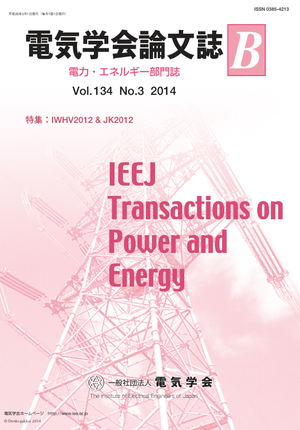Experimental Investigation and Numerical Analysis of Surface Charge Decay on Acrylic and Glass Epoxy Multilayer Materials in Air
Experimental Investigation and Numerical Analysis of Surface Charge Decay on Acrylic and Glass Epoxy Multilayer Materials in Air
カテゴリ: 論文誌(論文単位)
グループ名: 【B】電力・エネルギー部門
発行日: 2014/03/01
タイトル(英語): Experimental Investigation and Numerical Analysis of Surface Charge Decay on Acrylic and Glass Epoxy Multilayer Materials in Air
著者名: Takao Matsumoto (Faculty of engineering, Fukuoka University), Daisuke Kunishige (Faculty of engineering, Fukuoka University), Yasuji Izawa (Faculty of engineering, Fukuoka University), Kiyoto Nishijima (Faculty of engineering, Fukuoka University)
著者名(英語): Takao Matsumoto (Faculty of engineering, Fukuoka University), Daisuke Kunishige (Faculty of engineering, Fukuoka University), Yasuji Izawa (Faculty of engineering, Fukuoka University), Kiyoto Nishijima (Faculty of engineering, Fukuoka University)
キーワード: surface charge,charge decay,dielectric,DC corona,acrylic,glass epoxy multilayer
要約(英語): Surface charge decay on dielectric materials in atmospheric air was studied. A dielectric circular disc placed on a plane electrode in a rod-plane air gap was charged by positive or negative DC corona discharge. The dielectric discs with a thickness of 0.1cm made of acrylic and glass epoxy multilayer have 16.0cm in diameters. The surface potential induced from accumulated surface charge was measured by an electrostatic voltmeter which can be controlled automatically by a computer at 0.5 cm intervals in the direction of X and Y. In case of the acrylic disc, it was observed that a bell shaped initial surface potential distribution decayed into a crater like shaped with time. The simulation model based on a charge neutralization mechanism by gas ions reproduced the measured result well. In contrast, in case of the glass epoxy multilayer disc, a bell shaped initial surface potential distribution sunk overall. Furthermore, the decay rate of surface charge on glass epoxy multilayer disc was relatively fast in comparison to the acrylic case. Besides the charge neutralization, it can be considered that electric conduction through the volume of the glass epoxy multilayer occurred because of its low volume resistivity.
本誌: 電気学会論文誌B(電力・エネルギー部門誌) Vol.134 No.3 (2014) 特集:IWHV2012 & JK2012
本誌掲載ページ: 203-209 p
原稿種別: 論文/英語
電子版へのリンク: https://www.jstage.jst.go.jp/article/ieejpes/134/3/134_203/_article/-char/ja/
受取状況を読み込めませんでした


